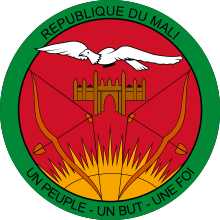Location
The Sudanese Republic and Senegal became independent of France in 1960 as the Mali Federation. When Senegal withdrew after only a few months, what formerly made up the Sudanese Republic was renamed Mali. Rule by dictatorship was brought to a close in 1991 by a military coup that ushered in a period of democratic rule. President Alpha KONARE won Mali's first two democratic presidential elections in 1992 and 1997. In keeping with Mali's two-term constitutional limit, he stepped down in 2002 and was succeeded by Amadou Toumani TOURE, who was elected to a second term in a 2007 election that was widely judged to be free and fair. Malian returnees from Libya in 2011 exacerbated tensions in northern Mali, and Tuareg ethnic militias rebelled in January 2012. Low- and mid-level soldiers, frustrated with the poor handling of the rebellion, overthrew TOURE on 22 March. Intensive mediation efforts led by the Economic Community of West African States (ECOWAS) returned power to a civilian administration in April with the appointment of Interim President Dioncounda TRAORE. The post-coup chaos led to rebels expelling the Malian military from the country's three northern regions and allowed Islamic militants to set up strongholds. Hundreds of thousands of northern Malians fled the violence to southern Mali and neighboring countries, exacerbating regional food shortages in host communities. An international military intervention to retake the three northern regions began in January 2013 and within a month most of the north had been retaken. In a democratic presidential election conducted in July and August of 2013, Ibrahim Boubacar KEITA was elected president. The Malian Government and northern armed groups signed an internationally-mediated peace accord in June 2015.
Mali is a semi-presidential republic.
Source: CIA World Factbook
Members:
Resources
Displaying 76 - 80 of 107Décret n° 10-453-P-RM du 16 août 2010 déterminant le cadre organique de la Direction Nationale de l’aménagement du Territoire.
Le présent décret définit le cadre organique (structures et effectifs) de la Direction Nationale de l’Aménagement du Territoire.
Met en oeuvre: Décret n°10-441/P-RM du 16 août 2010 fixant l’organisation et les modalités de fonctionnement de la Direction Nationale de l’Aménagement du territoire. (2010-08-16)
Arrêté n°05-1986 MHU-SG du 29 août 2005 fixant les conditions d’obtention des autorisations de réalisation des opérations d’urbanisme.
Le présent arrêté fixe les conditions d’obtention des autorisations de réalisation des opérations d’urbanisme ci-après: le lotissement; la division parcellaire; l’opération concertée d’extension urbaine; la réhabilitation urbaine; la restructuration urbaine; la restauration urbaine; la rénovation urbaine.
Arrêté n° 1447-MLAFU-SG du 18 juin 2009 fixant l'organisation et les modalités de fonctionnement de la cellule d'appui à la décentralisation/déconcentration du logement, des affaires foncières et domaniales et de l'urbanisme.
Le présent arrête fixe l’organisation et les modalités de fonctionnement de la Cellule d'Appui à la Décentralisation/Déconcentration du Logement, des Affaires Foncières et Domaniales et de l'Urbanisme.
Arrêté n°05-1988 MHU-SG du 29 août 2005 déterminant la structure du règlement du plan d’urbanisme sectoriel.
Le présent arrêté fixe la structure du règlement du plan d’urbanisme sectoriel.En effet, le règlement du Plan d’Urbanisme Sectoriel est un ensemble de dispositions et de prescriptions techniques pour sa mise en œuvre correcte.La structure du Règlement du Plan d’Urbanisme Sectoriel est annexée au présent arrêté dont elle fait partie intégrante.
Loi n° 06-063 du 29 décembre 2006 portant modification de la Loi n° 97-026 du 20 mai 1997 régissant la profession de Géomètre Expert.
La présente loi modifie les dispositions des articles 2 et 3 de la loi n° 97-026 du 20 mai 1997 régissant la profession de Géomètre Expert.Aux termes de l’article 2 (nouveau), le Géomètre Expert procède en son nom et sous sa responsabilité au cours les opérations qu’il entreprend dans le domaine foncier, notamment les opérations topographiques de foncier et de cadastre ; la matérialisation des limites des biens fonciers, les opérations techniques ou aux études se rapportant aux travaux cadastraux et de lotissement, à l’évaluation, au partage, à la fusion ou à la mutation des biens fonciers.


